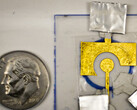A team of engineers has developed a low-cost method for 3D-printing titanium that is both stronger and more ductile than commonly used alloys. The innovation — which the team has described as a “full leap forward” — could make high-grade titanium more accessible for a wide range of industries.
Given the current cost gap between 3D-printed (currently used in aerospace and others) and machined titanium (currently used in consumer electronics), this new development will need more improvements to debut in smartphones and laptops, if it ever does. In the near-term, this innovation could have a direct impact in aerospace and medicine. The new alloy, which the researchers say results in 29% reduction in production cost, could enable manufacturers to make more durable components at a lower cost.
This innovative approach solves key challenges that have hindered the adoption of 3D-printed titanium — the design framework allows for 3D-printed titanium with a more uniform grain structure, without the column shaped microstructures that lead to uneven strength, all at a cheaper rate.
We have been able to not only produce titanium alloys with a uniform grain structure, but with reduced costs, while also making it stronger and more ductile. — Ryan Brooke, the study's lead author.
The university has filed a provisional patent on the new procedure and the team is now looking for partners to help commercialize the technology, with immediate focus on aerospace and medical devices.
Source(s)
Nature Communications via RMIT News
Image source: Kat von Wood




















